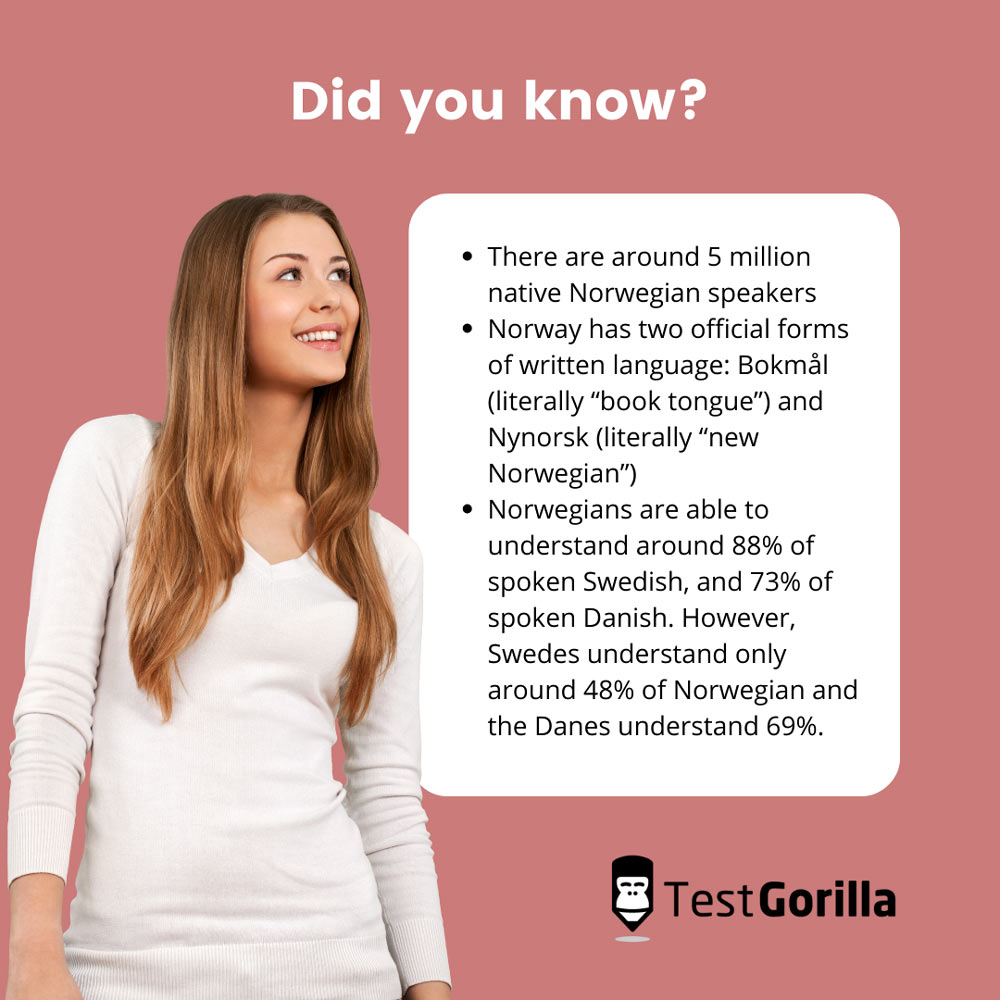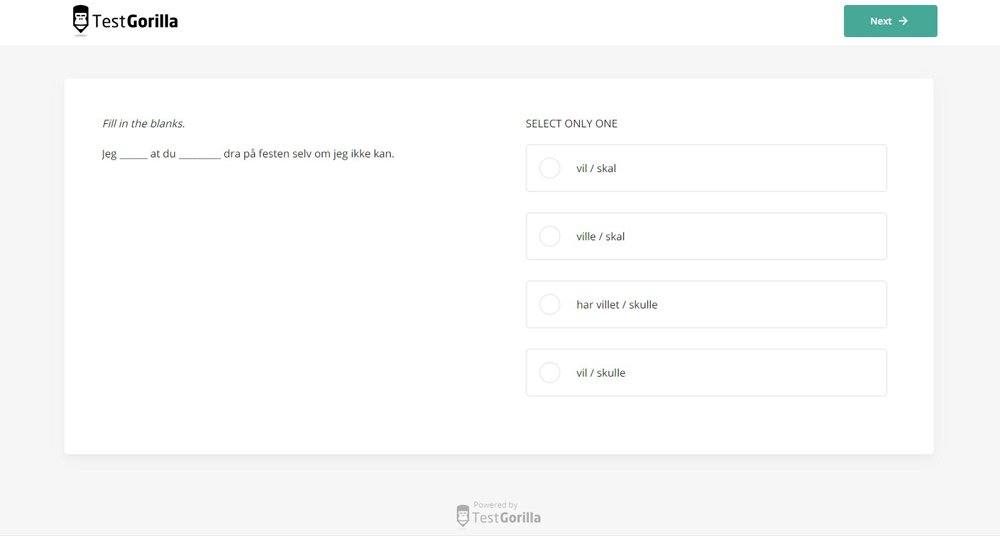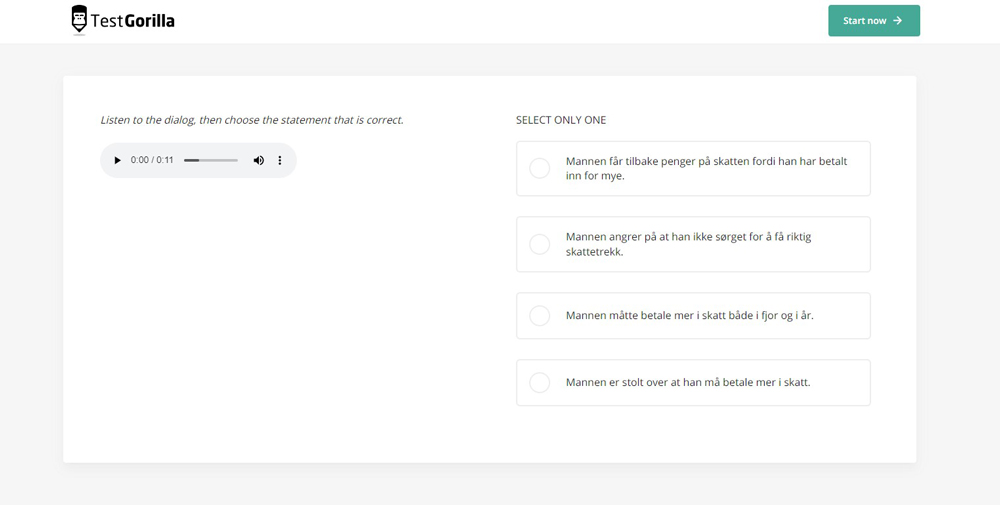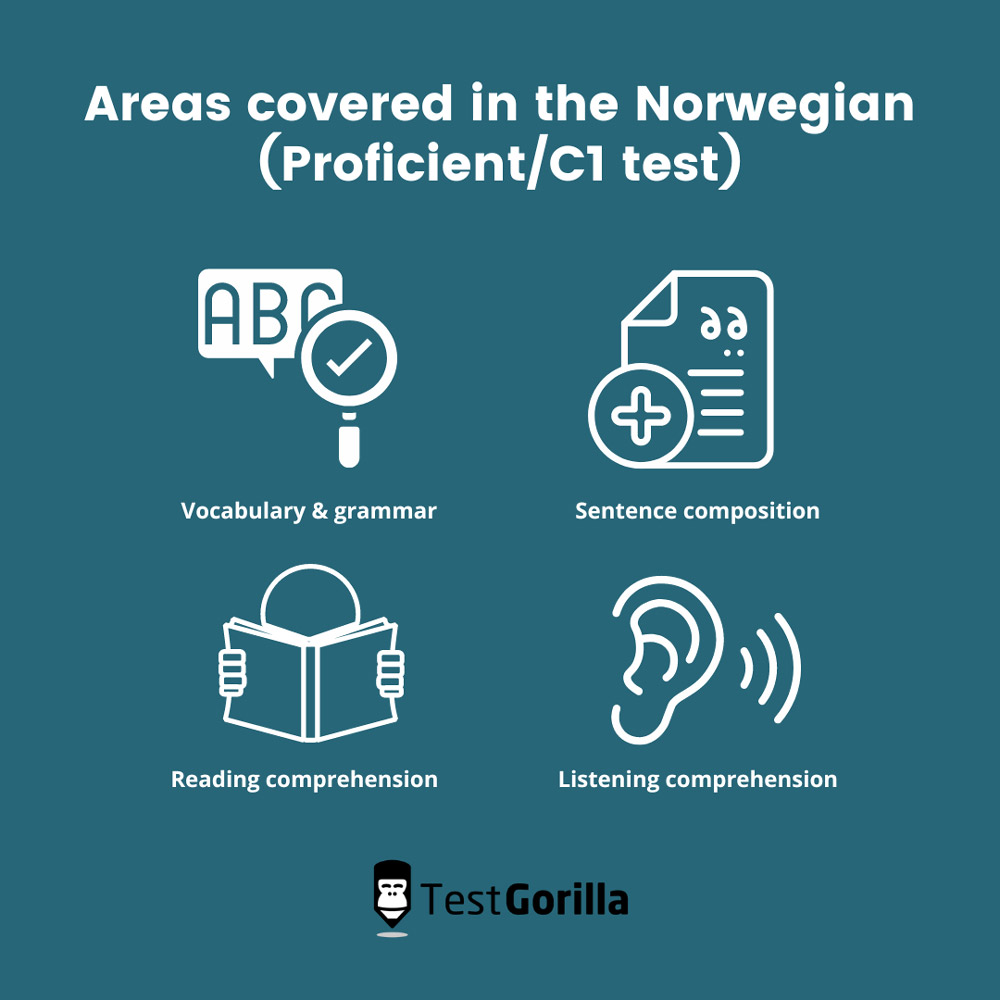Finding experts in the Norwegian language isn’t always easy. Unless you personally know fluent Norwegian speakers who can sit in with you at an interview, how do you tell if candidates have the Norwegian language skill level that you need?
The answer is simple. Use a C1 level Norwegian language test to screen candidates before the interview stage.
We’re going to show you how to hire the best Norwegian language experts for your organization using our pre-employment language tests as part of a wider skills assessment.
First, though, let’s look at what C1/proficient level Norwegian means within the CEFR framework.
The CEFR framework
There are different levels of ability to communicate in a specific language. Someone may only have a basic understanding of Norwegian, while others may be able to hold an in-depth conversation or write a complicated text in the language.
At the C1 Norwegian CEFR level, a student can:
In order to standardize and align language fluency levels, the Common European Framework of Reference (CEFR) for languages built a simple framework from A1 through to C2, with each level representing a growing mastery of the language.
Understand a wide range of demanding, longer clauses, and also recognize implied meaning in Norwegian
Express thoughts and ideas fluently without much obvious thinking about it or searching for expressions
Use the Norwegian language effectively in social, academic, and professional settings
Produce clear, detailed, and well-structured Norwegian text on complex subjects
C1 level Norwegian is considered advanced and shows the holder fully understands Norwegian grammar and vocabulary. The only higher CEFR level is C2, which even native Norwegian speakers don’t always reach. C1 is the desired level of proficiency for most employers and many jobs of medium to high complexity.
Those with a Norwegian C1 level grasp of the language can do just about any job role that requires a good understanding of written and spoken Norwegian.
Testing your candidates’ Norwegian proficiency is useful for:
Hiring remotely or from abroad
Hiring for company offices in a Norwegian-speaking country
Hiring for roles that attract a lot of foreign candidates
Hiring for customer-facing positions where the employee will be working in a foreign language
Steps to hire C1/proficient Norwegian speakers
We’re going to take you through the steps to successfully hire expert Norwegian speakers, and show you how using our Norwegian language test can save you money and reduce time-to-hire.
Despite many claims that Norwegian is one of the easiest languages for English speakers to learn, there are many challenges to overcome in order to become proficient.
One of them is dialect. If your candidates are going to be mainly speaking to those in and around Oslo, then standard Norwegian is fine.
However, if you are hiring someone who needs to communicate with those from Stavanger, Bergen, Trondheim, rural Norway, or the Arctic region, they need to know the ins and outs of the local dialects.
One of the hardest to get to grips with is the dialect spoken around Trondheim and central Norway, so you may want to ask candidates if they understand and can talk in these dialects.
The best insights on HR and recruitment, delivered to your inbox.
Biweekly updates. No spam. Unsubscribe any time.
Decide on the level of language proficiency needed
What are the specific language requirements needed for your open job role? Do you need a Norwegian C1-level expert, or will a B2-level understanding of the language be enough?
Because of the different levels of proficiency, you’ll need to look at the job requirements and responsibilities to better understand the language proficiency level that you really need, and that you should be testing for.
Some good questions to ask yourself when deciding include:
How complex is the role? An entry-level job at a retail store or bar requires less Norwegian proficiency than a salesperson, manager, or customer service representative. If you decide that a C1-level Norwegian language test isn’t necessary, we also have a test for the Norwegian B1/intermediate level.
Will this role develop into something that may need a more fluent Norwegian speaker? If you think the job scope will broaden and there will be a need for a higher level of Norwegian in the future, then it would be best to look for someone with that level of proficiency now instead of leaving it until later.
Does the role involve working with a team? Although an employee’s day-to-day tasks may not require a high level of Norwegian understanding, if they work in a team they still need to be able to communicate effectively with their colleagues in Norwegian.
Create an effective job description
Now you’ve decided on the level of Norwegian proficiency needed for the role, it’s time to write and post that job advertisement.
One of the key areas that make a job ad good is a full and honest job description, and when you are looking for language skills it’s important to specify exactly which level of CEFR ability you need in the candidate requirements section. If you’re not sure how to go about creating job descriptions, we have a handy guide on how to write great job descriptions, and it even includes a job description template so you can get started straight away.
The next step after posting your job advert is to set up a reliable and accurate Norwegian language test that your candidates can do online.
Use our Norwegian language test to screen candidates
When you use a Norwegian language test as part of your hiring process, you save time by filtering out those who don’t have the required level of language skills.
This means you don’t have to waste time interviewing candidates who don’t have the necessary Norwegian language skills. This streamlines the hiring process to help you save both time and money.
The Norwegian language test (like all our language tests) works best when paired with other skills tests in a full pre-employment assessment. Our assessments give you the choice of adding up to five different tests, which may include cognitive ability tests or other role-specific tests like the Customer Service test.
This enables you to evaluate all the skills of the applicants, and only move forward with those who meet your requirements. If you’re interested in learning more about testing language skills, our guide to language proficiency tests may be of interest to you.
Our Norwegian (proficient/C1) test evaluates a candidate’s ability to communicate at the C1 level. The test evaluates their skills in the areas of:
Norwegian grammar and vocabulary
Sentence composition
Reading comprehension
Listening comprehension (including listening comprehension in some regional accents and dialects)
The preview questions below are from the Norwegian language test:
The question above asks candidates to choose the correct words to complete the sentence, and the one below evaluates their listening and comprehension skills by using an audio clip:
You can also add custom questions to the Norwegian language test in order to make it align more closely with the role you are hiring for.
For example, you may need employees who must use specific terms at work, like medical or legal staff. TestGorilla makes it easy for you to add custom questions to accurately assess the level of language proficiency of your applicants in your specific field.
Although listening is already part of our language tests, you can also test for it by creating one or more custom video questions. You can effectively test for spoken Norwegian skills by asking candidates to record a video answer to a question, and the skill level of reading and writing in Norwegian can be evaluated with custom questions.
Assess the results
After the candidates have completed their Norwegian language test (or full skills assessment), it’s time for you to review the results.
At TestGorilla, we make analyzing the results easy. You can see at a glance how the candidates ranked in the Norwegian language test, and find the best candidates with output reports, rankings, and analytics. You can also switch from a comprehensive overview to a detailed analysis of the applicants.
If you created custom questions with video or written answers and you don’t speak fluent Norwegian yourself, you may find it a good idea to have a native or C1-level Norwegian speaker evaluate the answers with you.
When you have looked at all the results, it’s time to make an interview shortlist and prepare your questions.
Take the next step in hiring expert Norwegian speakers with TestGorilla
You may be wondering why we haven’t mentioned CVs/resumes in our steps to hire expert Norwegian speakers. That’s because we think CVs are no longer fit for purpose in the modern world, and that skills testing is a fairer, faster, and more accurate way to find the best candidates.
The unpleasant truth about CVs is that one in every three Americans admits to openly lying about their level of skills or qualifications. Finding out that a candidate lied about their language skills at the interview means you’ve already wasted precious time on the recruitment process with them.
With high-quality language proficiency tests such as our Norwegian language test written by subject-matter experts, you can make your recruitment process much easier and faster.
Tests allow you to quickly see who has the necessary language skills for the role, and who is simply not at the level of Norwegian proficiency that you need.
By combining our C1 Norwegian language test with a wider skills assessment, you are well on your way to finding a great fit for the role you have in mind.
Sign up for your free plan to get started on building your first assessment. If you want more information or to see how our products work first-hand, book a free 30-minute live demo with our sales team, who will be pleased to answer any questions you may have.
You've scrolled this far
Why not try TestGorilla for free, and see what happens when you put skills first.


















